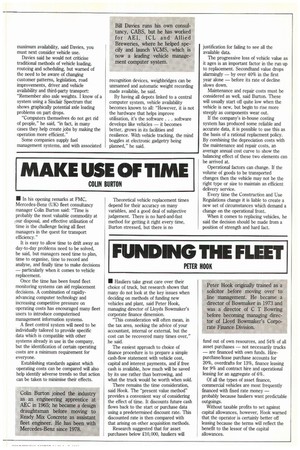MAKE USE OF TIME
Page 41

If you've noticed an error in this article please click here to report it so we can fix it.
COLIN BURTON • In his opening remarks at FMC, Mercedes-Benz (UK) fleet consultancy manager Colin Burton said: "Time is probably the most valuable commodity at our disposal, and effective utilisation of time is the challenge facing all fleet managers in the quest for transport efficiency," It is easy to allow time to drift away as day-to-day problems need to be solved, he said, but managers need time to plan, time to organise, time to record and analyse, and finally time to make decisions — particularly when it comes to vehicle replacement.
Once the time has been found fleet monitoring systems can aid replacement decisions. A combination of rapidlyadvancing computer technology and increasing competitive pressure on operating costs has encouraged many fleet users to introduce computerised management information systems.
A fleet control system will need to be individually tailored to provide specific data which is compatible with other systems already in use in the company, but the identification of certain operating costs are a minimum requirement for everyone.
Establishing standards against which operating costs can be compared will also help identify adverse trends so that action can be taken to minimise their effects. Theoretical vehicle replacement times depend for their accuracy on many variables, and a good deal of subjective judgement. There is no hard-and-fast method for getting it right every time, Burton stressed, but there is no justification for failing to see all the available data.
The progressive loss of vehicle value as it ages is an important factor in the run up to replacement. Secondhand value drops alarmingly — by over 40% in the first year alone — before its rate of decline slows down.
Maintenance and repair costs must be considered as well, said Burton. These will usually start off quite low when the vehicle is new, but begin to rise more steeply as components wear out.
If the company's in-house costing system has produced some reliable and accurate data, it is possible to use this as the basis of a rational replacment policy. By combining the depreciation costs with the maintenance and repair costs, an average annual cost curve to show the balancing effect of these two elements can be arrived at.
Operational factors can change. If the volume of goods to be transported changes then the vehicle may not be the right type or size to maintain an efficient delivery service.
Every time the Construction and Use Regulations change it is liable to create a new set of circumstances which demand a change on the operational front.
When it comes to replacing vehicles, he said the decision should be made from a position of strength and hard fact.












































































































